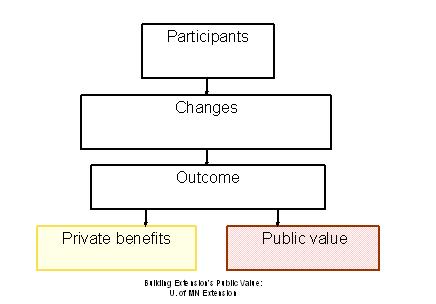I got some constructive feedback on a recent four-hour “Building Extension’s Public Value” workshop that I taught here at the University of Minnesota for NELD. While the evaluations were largely positive, I also heard that some participants grew weary toward the end of the workshop and even “checked out” during the later small group exercises. One participant wrote on the evaluation form, “Content was very good, but a very long time sitting with no activity.”
This lead me to search for activities I might include in the second half of the workshop–which often occurs in the sleepy after-lunch hours–that would get people up out of their seats and moving around. I admit that I am torn, because even without adding new activities, it is hard to achieve all of an organization’s workshop goals in the allocated time. So, I do not want to add anything to the workshop that doesn’t advance the BEPV learning objectives.
My search brought me to the University of Minnesota’s Techniques in Learning and Teaching (TILT) blog. The October 17, 2011, entry is about reinvigorating student learning during the “mid-term slump.” My issue is more with a “late-workshop slump,” but I’m willing to try some of the suggested techniques. For example, I think I can adapt the flipchart-page-synthesizing technique to the BEPV workshop. It is described here:
“Version 2: Create four flip chart pages, each with its own unique synthesizing question and post each page at different locations around the room. Group students in 3s or 4s and have them discuss the question on one chart, come to a consensus, and then record their thoughts. At a designated time all groups rotate to a new flip chart, review and respond to previous groups and raise new questions. By focusing the four questions on a specific, common-to-all case or scenario, students must draw on all they have studied to analyze and address the discrete components of an overall problem, while also reflecting on how content and coherence of previous commenters.”
I can think of two ways this technique might work:
(1) I could use the activity to help participants synthesize the main content of the BEPV workshop (modules 1-4): the criteria for public sector action. I’m not yet sure what the “unique synthesizing questions” for the flipchart pages would be…perhaps something like, “Can the criteria for public sector involvement be used to justify public funding for any Extension program?” Alternatively, each flipchart page could simply hold one of the criteria, as identified in the slide below, and groups would add to each page examples of Extension programs that satisfy the criterion.

(2) After participants complete the “Demonstrating Extension’s Public Value” activity (module 8), but before they refine their work with the public value message template (module 8.1), I could post draft public value messages on four flipchart pages. The messages would come from elsewhere, i.e., not from the workshop participants. I would sort participants into new small groups, as explained in the TILT blog excerpt, and ask each small group to critique the draft messages. Perhaps they could re-draft the messages on the flipchart pages. If there is enough time, I could rotate the small groups through the flipchart pages, asking them to improve upon the previous groups’ work, if possible. The slide below, providing some guidelines for drafting messages, could serve as a resource for the activity.

What are your reactions to these ideas? Is it worthwhile trying to invigorate the second half of the workshop with a get-up-and-move-around activity? Do you think the suggested activities would help accomplish the learning objectives, and not simply add minutes onto a tight agenda?











